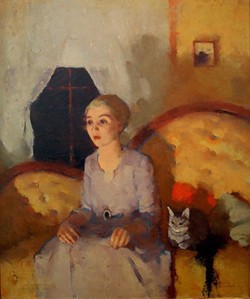
EXHIBIT: "Masters of Vermont 2007," paintings by Martha Wood Belcher, Hilda Belcher, Georgia Balch, Ruth G. Mould and Mary Bryan. Bryan Memorial Gallery, Jeffersonville. Through June 17.
ARTWORK:"Tomorrow and Tomorrow" by Hilda Belcher
Masterful paintings by five eminent female artists from Vermont are featured at Jeffersonville's Bryan Memorial Gallery this spring in the historical exhibition "Masters of Vermont 2007." More than 100 oils, watercolors and pastels, executed over a span of more than a century, have been gathered for this groundbreaking show. It amply represents Georgia Balch (1888-1981), Ruth G. Mould (1894-1979), Mary Bryan (1906-1978) - for whom the gallery is named - Martha Wood Belcher (1844-1930) and Hilda Belcher (1881-1963). All worked at a time when women were far less prominent in the visual arts than they are today.
Bryan's "Bird Sanctuary" is a vibrant 20-by-30-inch oil. It's executed in the choppy, palette-knife style of decorative modernism often found in objective painting from the era of Abstract Expressionism. Two white birds with bowed heads seem to coo before a background of heavily textured, brown and blue vertical bands. But Bryan's more traditional watercolors, such as the 5-by-7-inch "Mountain View," are typical of most of the pieces in the show. While all the artists were well trained in a variety of genres, realist landscapes referring to New England's pastoral beauty dominate this display.
Mould's exquisite pastel "Winter Landscape" is an 8-by-11-inch snow scene focusing on a sweeping hillside pathway in the foreground; in the background are snow-burdened conifers and leafless deciduous trees. Her 9-by-10-inch oil "Winter Landscape with Barn" employs the same device - a sinuous path on the side of a snowy hill. A red barn enlivens the complementary greens of the pines.
Winter also takes center stage in Balch's 20-by-26-inch "The Skier," in which a tiny figure appears at the summit of a jagged mountain. While that peak looks more like a Swiss one than any Green Mountain, the painting no doubt would have been popular with early Vermont ski enthusiasts. It's important to remember the context in which these painters created. All were working artists. Balch, for example, plied her trade to tourists; a sign reading "Paintings of Vermont by Georgia Balch" hung in front of her Johnson home on Route 100C.
The Belchers are perhaps the most fascinating painters of this exhibition. Martha Wood Belcher emigrated from England before the American Civil War. After the death of her brother in that war and that of her elderly father in 1865, she relied on the income from painting sales to raise her three daughters. Martha's landscape "View from Fred's" is a 9-by-17-inch oil that seems more influenced by the 18th-century landscapes of English painter Thomas Gainsborough than by the Hudson River School idylls so prominent in 19th-century American art.
Daughter Hilda grew up to be equally well informed. She studied with the American Impressionist William Merritt Chase, as well as Ashcan School greats George Bellows and Robert Henri, around the turn of the century. Hilda's brushwork is brilliantly loose and her compositions sophisticated, as exemplified by the 36-by-30-inch "Tomorrow and Tomorrow," a 1934 portrait of her elderly Pittsford neighbor Helen Barnes.
A pair of New York City scenes with the same subject, created by both Belchers in 1910, hang side by side in the show. Martha's 9-by-12-inch oil, "Snowscape: Subway Arch in New York," and Hilda's 6-by-6-inch "Viaduct in Snow" poignantly demonstrate how mother and daughter influenced each other - in seemingly equal measures.
Hilda Belcher is the best-known painter of the exhibition. In a 1995 article in American Art Review, Fleming Museum Director Janie Cohen wrote that Hilda's work could be seen as "a private world articulated in the finest realist tradition of its time, by one of the most accomplished and successful painters of that time."
The under-representation of women in the arts has been somewhat corrected over the last 30 years, thanks in part to organizations such as the Women's Caucus on the Arts and the National Museum of Women in the Arts. But the major factor in leveling the playing field has been the hard work and excellence of female artists themselves. Given the impact of women in contemporary art, this exhibition of earlier work may be one of the most important Vermont art events of the year.










Comments
Comments are closed.
From 2014-2020, Seven Days allowed readers to comment on all stories posted on our website. While we've appreciated the suggestions and insights, right now Seven Days is prioritizing our core mission — producing high-quality, responsible local journalism — over moderating online debates between readers.
To criticize, correct or praise our reporting, please send us a letter to the editor or send us a tip. We’ll check it out and report the results.
Online comments may return when we have better tech tools for managing them. Thanks for reading.